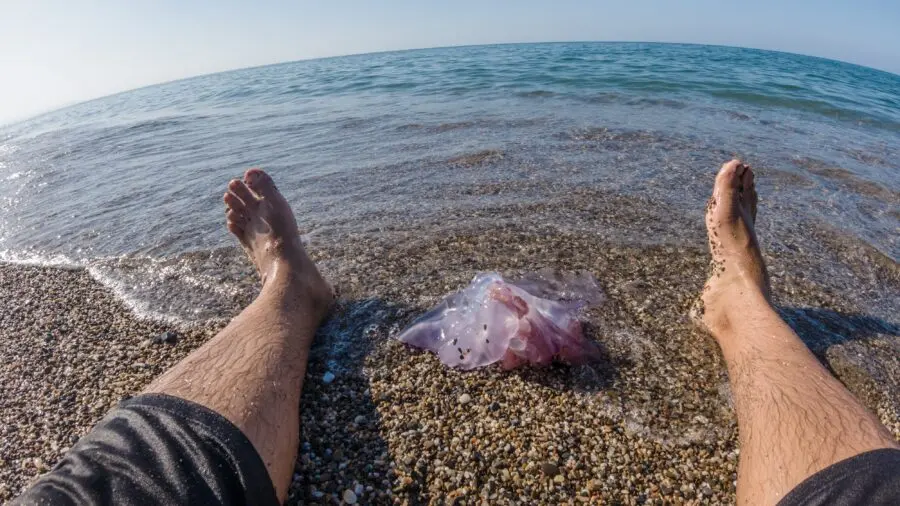
Complete Guide and Practical Tips
Jellyfish are becoming increasingly common. Treating a jellyfish sting on the foot is essential to avoid complications and prolonged pain. Let’s explore the symptoms of this type of injury and how to treat it effectively.
Symptoms of a jellyfish sting on the foot
You are having a great time playing in the water when you get what seems like an electric jolt to the foot. Most likely, you were stung by a jellyfish, which happens when the stinging cells on its tentacles come into touch with your skin.
The sting victim will typically experience a burning sensation of varying intensity after the first severe pain has subsided, followed by itching and red skin sores (pimples or patches).
Other symptoms, such as headaches, dizziness, nausea, or trouble breathing, may occasionally arise after being stung by a jellyfish, especially if the person is allergic.
Although they can seem insignificant, these stings should not be ignored and need to be treated at once.
Foot treatments for jellyfish stings
There are a number of things to do if you detect a jellyfish sting. When you first leave the water, gently wipe away any tentacle residue still on your foot’s flesh. Next, thoroughly rinse with seawater, being careful not to rub (particularly not with clear water!). If you happen to have vinegar on hand, it could be a good idea to mix it with some water before applying it to the sting.
When you get home, use a sterile compress and an antiseptic solution to clean the wound. Dab softly. You might use an antihistamine cream to soothe the reaction if necessary.
Be careful; if the sting is still painful after 48 hours or if the wound’s state does not improve, you must act swiftly to see a doctor who can properly diagnose and treat your foot.
What not to do when treating a jellyfish sting
There are a few myths regarding the treatment of a jellyfish sting that have made their way into popular culture. It’s a good idea to revisit these false beliefs that will certainly not help your foot heal. You should be aware that one of the most prevalent examples is that you should not urinate on the wound because doing so could infect it. Furthermore, avoid rinsing your wounded foot with fresh water because doing so will just make the pain worse by causing the venom to be released.
Other helpful tips include not putting the wound in your mouth to suck out the venom, not putting alcohol on the affected area, not making an incision in the wound, and not applying a compression bandage.
Other foot injuries at the beach
Aside from jellyfish stings, the beach poses other risks for foot injuries. You might cut yourself on sharp shells, step on sea urchins, or unknowingly walk over glass fragments buried in the sand. In such cases, it’s crucial to remove any foreign object—either yourself or with help from a podiatrist—thoroughly disinfect the wound, and avoid swimming until the area has fully healed.
Another risk that is often overlooked is the burning of the arch of the foot on the sand or sunburn on top of the foot.
It might be a good idea to wear beach shoes to prevent all these unpleasant problems. Last but not least, remember to use a high-protection factor sunscreen on the skin on your feet.
Frequently Asked Questions About Treating a Jellyfish Sting on the Foot
What should you do immediately after a jellyfish sting on the foot?
As soon as you feel pain, calmly exit the water to avoid further stings. Do not rub the affected area. Gently remove any tentacle remnants using tweezers or a rigid object like a credit card. Then, rinse the area thoroughly with seawater or a diluted vinegar solution. Avoid using fresh water at all costs, as it can intensify the pain by triggering more venom release.
Can you use ice to relieve the pain from a jellyfish sting?
Yes, but with caution. A cold compress or an ice pack wrapped in a cloth can help reduce pain and swelling. However, never apply ice directly to the skin, as this could cause frostbite. Limit each application to 10 to 15 minutes, alternating with breaks.
Are there natural remedies to ease the pain of a jellyfish sting?
Some natural solutions may help ease discomfort, though they are not a substitute for medical treatment. A mix of baking soda and water can partially neutralize the venom. Aloe vera is also known for its soothing and healing properties. Keep in mind: these remedies are only complementary and should not delay disinfection or a medical consultation if needed.
Can jellyfish stings be prevented while swimming?
- Wear water shoes or swim socks.
- Avoid areas marked with jellyfish warnings or flags.
- Consider wearing a lightweight wetsuit in high-risk waters.
- Check local beach advisories before entering the water.
Never disregard a jellyfish sting on your foot
A jellyfish sting can be unpleasant and leave unsightly scars even though it is typically not serious. Nonetheless, it is critical to appropriately manage this kind of injury and, if necessary, seek competent medical assistance.
Have you been stung by a jellyfish, and are you still in pain, or does the area seem to be getting worse? To get the help you need, book a visit with a FootNetwork podiatrist right away.